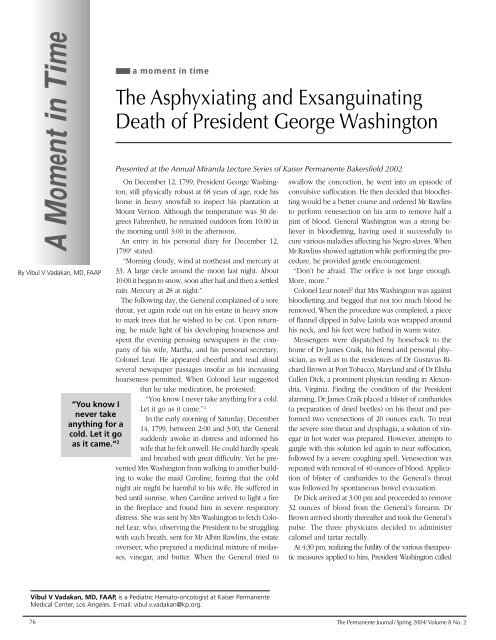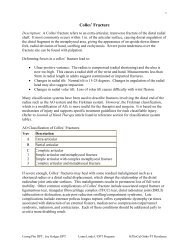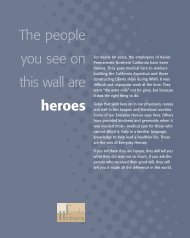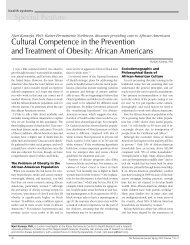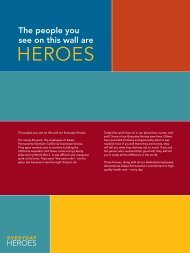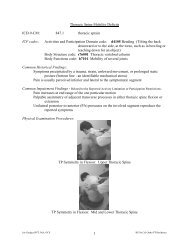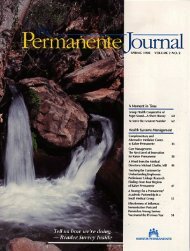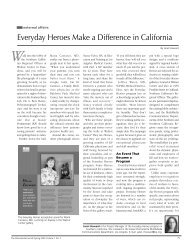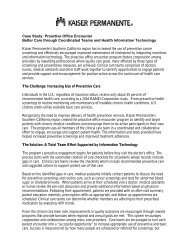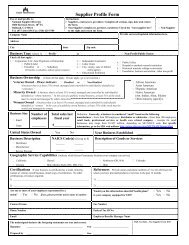The Asphyxiating and Exsanguinating Death of President George
The Asphyxiating and Exsanguinating Death of President George
The Asphyxiating and Exsanguinating Death of President George
- No tags were found...
Create successful ePaper yourself
Turn your PDF publications into a flip-book with our unique Google optimized e-Paper software.
A Moment in Timea moment in time<strong>The</strong> <strong>Asphyxiating</strong> <strong>and</strong> <strong>Exsanguinating</strong><strong>Death</strong> <strong>of</strong> <strong>President</strong> <strong>George</strong> WashingtonPresented at the Annual Mir<strong>and</strong>a Lecture Series <strong>of</strong> Kaiser Permanente Bakersfield 2002On December 12, 1799, <strong>President</strong> <strong>George</strong> Washington,still physically robust at 68 years <strong>of</strong> age, rode hishorse in heavy snowfall to inspect his plantation atMount Vernon. Although the temperature was 30 degreesFahrenheit, he remained outdoors from 10:00 inthe morning until 3:00 in the afternoon.An entry in his personal diary for December 12,1799 1 stated:“Morning cloudy, wind at northeast <strong>and</strong> mercury atBy Vibul V Vadakan, MD, FAAP 33. A large circle around the moon last night. About10:00 it began to snow, soon after hail <strong>and</strong> then a settledrain. Mercury at 28 at night.”<strong>The</strong> following day, the General complained <strong>of</strong> a sorethroat, yet again rode out on his estate in heavy snowto mark trees that he wished to be cut. Upon returning,he made light <strong>of</strong> his developing hoarseness <strong>and</strong>spent the evening perusing newspapers in the company<strong>of</strong> his wife, Martha, <strong>and</strong> his personal secretary,Colonel Lear. He appeared cheerful <strong>and</strong> read aloudseveral newspaper passages ins<strong>of</strong>ar as his increasinghoarseness permitted. When Colonel Lear suggestedthat he take medication, he protested:“You know I never take anything for a cold.“You know ILet it go as it came.” 2never takeIn the early morning <strong>of</strong> Saturday, Decemberanything for a14, 1799, between 2:00 <strong>and</strong> 3:00, the Generalcold. Let it gosuddenly awoke in distress <strong>and</strong> informed hisas it came.” 2wife that he felt unwell. He could hardly speak<strong>and</strong> breathed with great difficulty. Yet he preventedMrs Washington from walking to another buildingto wake the maid Caroline, fearing that the coldnight air might be harmful to his wife. He suffered inbed until sunrise, when Caroline arrived to light a firein the fireplace <strong>and</strong> found him in severe respiratorydistress. She was sent by Mrs Washington to fetch ColonelLear, who, observing the <strong>President</strong> to be strugglingwith each breath, sent for Mr Albin Rawlins, the estateoverseer, who prepared a medicinal mixture <strong>of</strong> molasses,vinegar, <strong>and</strong> butter. When the General tried toswallow the concoction, he went into an episode <strong>of</strong>convulsive suffocation. He then decided that bloodlettingwould be a better course <strong>and</strong> ordered Mr Rawlinsto perform venesection on his arm to remove half apint <strong>of</strong> blood. General Washington was a strong believerin bloodletting, having used it successfully tocure various maladies affecting his Negro slaves. WhenMr Rawlins showed agitation while performing the procedure,he provided gentle encouragement.“Don’t be afraid. <strong>The</strong> orifice is not large enough.More, more.”Colonel Lear noted 2 that Mrs Washington was againstbloodletting <strong>and</strong> begged that not too much blood beremoved. When the procedure was completed, a piece<strong>of</strong> flannel dipped in Salve Latola was wrapped aroundhis neck, <strong>and</strong> his feet were bathed in warm water.Messengers were dispatched by horseback to thehome <strong>of</strong> Dr James Craik, his friend <strong>and</strong> personal physician,as well as to the residences <strong>of</strong> Dr Gustavus RichardBrown at Port Tobacco, Maryl<strong>and</strong> <strong>and</strong> <strong>of</strong> Dr ElishaCullen Dick, a prominent physician residing in Alex<strong>and</strong>ria,Virginia. Finding the condition <strong>of</strong> the <strong>President</strong>alarming, Dr James Craik placed a blister <strong>of</strong> cantharides(a preparation <strong>of</strong> dried beetles) on his throat <strong>and</strong> performedtwo venesections <strong>of</strong> 20 ounces each. To treatthe severe sore throat <strong>and</strong> dysphagia, a solution <strong>of</strong> vinegarin hot water was prepared. However, attempts togargle with this solution led again to near suffocation,followed by a severe coughing spell. Venesection wasrepeated with removal <strong>of</strong> 40 ounces <strong>of</strong> blood. Application<strong>of</strong> blister <strong>of</strong> cantharides to the General’s throatwas followed by spontaneous bowel evacuation.Dr Dick arrived at 3:00 pm <strong>and</strong> proceeded to remove32 ounces <strong>of</strong> blood from the General’s forearm. DrBrown arrived shortly thereafter <strong>and</strong> took the General’spulse. <strong>The</strong> three physicians decided to administercalomel <strong>and</strong> tartar rectally.At 4:30 pm, realizing the futility <strong>of</strong> the various therapeuticmeasures applied to him, <strong>President</strong> Washington calledVibul V Vadakan, MD, FAAP, is a Pediatric Hemato-oncologist at Kaiser PermanenteMedical Center, Los Angeles. E-mail: vibul.v.vadakan@kp.org.76 <strong>The</strong> Permanente Journal/ Spring 2004/ Volume 8 No. 2
<strong>The</strong> <strong>Asphyxiating</strong> <strong>and</strong> <strong>Exsanguinating</strong> <strong>Death</strong> <strong>of</strong> <strong>President</strong> <strong>George</strong> Washingtona moment in timeColonel Lear to his bedside <strong>and</strong> gave his dying instruction.“I find I am going, my breath cannot last long; I believedfrom the first that the disorder would prove fatal.Do you arrange <strong>and</strong> record all my late military letters <strong>and</strong>papers, arrange my accounts <strong>and</strong> settle my books, as youknow more about them than anyone else. Let Mr Rawlinsfinish recording my other letters which he has begun.”When Dr Craik came back into the room, GeneralWashington said to him:“Doctor, I die hard but I am not afraid to go. I believedfrom my first attack that I should not survive it.My breath cannot last long.” 2Finally, as he felt the approach <strong>of</strong> death, he againspoke to the three attending physicians,“I feel myself going. I thank you for your attentionsbut I pray you take no more troubles about me. Let mego <strong>of</strong>f quietly. I cannot last long.” 2<strong>The</strong> three physicians remained with General Washingtonwell into the night. At 8:00, they applied blisters<strong>and</strong> cataplasms (poultices) <strong>of</strong> wheat bran to his legs.Dr Dick proposed that the <strong>President</strong>’s worsening respiratorycondition made it imperative that his tracheabe perforated. This newly described procedure, attemptedas a last therapeutic resort,had been reported to save the lives <strong>of</strong>patients in extremis. Both Drs Craik<strong>and</strong> Brown decided against permittingDr Dick to perform this procedureeven though the latter assured themthat he would assume all responsibilityin case <strong>of</strong> unfavorable outcome. DrDick subsequently noted in a personal correspondence:“I proposed to perforate the trachea as a means <strong>of</strong> prolonginglife <strong>and</strong> <strong>of</strong> affording time for the removal <strong>of</strong> theobstruction to respiration in the larynx which manifestlythreatened speedy resolution.” 3Sensing the inevitability <strong>of</strong> death, the General gavehis last instruction to Colonel Lear.“I am just going. Have me decently buried <strong>and</strong> donot let my body be put into the vault less than threedays after I am dead.“Do you underst<strong>and</strong> me? ’Tis well.”According to the account <strong>of</strong> Colonel Lear, 2 theGeneral’s breathing became less labored by about10:00 at night <strong>and</strong> he was able to lie quietly. At exactly10:10 pm, he lifted his h<strong>and</strong>s to check his ownpulse, then expired peacefully.Mrs Martha Washington was sitting at the foot <strong>of</strong> thebed when the first <strong>President</strong> <strong>of</strong> the United States died.When informed <strong>of</strong> her husb<strong>and</strong>’s demise, she said:“Is he gone? Tis well. All is now over. I shall soon… he lifted hish<strong>and</strong>s to check hisown pulse, thenexpiredpeacefully.follow him. I have no more trials topass through.”On December 19, 1799, five dayslater, Drs Craik <strong>and</strong> Dick publishedin <strong>The</strong> Times <strong>of</strong> Alex<strong>and</strong>ria the followingaccount: 4“Some time in the night <strong>of</strong>Friday, the 13th, having beenexposed to rain on the precedingday, General Washingtonwas attacked with aninflammatory affection <strong>of</strong> theupper part <strong>of</strong> the windpipe,called in technical language,cynanche trachealis. <strong>The</strong> diseasecommenced with a violent ague, accom- panied withsome pain in the upper <strong>and</strong> fore part <strong>of</strong> the throat, asense <strong>of</strong> stricture in the same part, a cough, <strong>and</strong> adifficult rather than painful deglutition, which were soonsucceeded by fever <strong>and</strong> a quick <strong>and</strong> laborious respiration.<strong>The</strong> necessity <strong>of</strong> blood-letting suggesting itself tothe General, he procured a bleeder in the neighborhood,who took from the arm in the night, 12 or 14ounces <strong>of</strong> blood; he would not by anymeans be prevailed upon by the familyto send for the attending physician tillthe following morning, who arrived atMount Vernon at 11:00 on Saturday morning.Discovering the case to be highlyalarming, <strong>and</strong> foreseeing the fatal tendency<strong>of</strong> the disease, two consulting physicianswere immediately sent for, who arrived, one athalf past three <strong>and</strong> the other at 4:00 in the afternoon. Inthe interim were employed two copious bleedings; ablister was applied to the part affected, two moderatedoses <strong>of</strong> calomel were given, an injection was administeredwhich operated on the lower intestines, but allwithout any perceptible advantage, the respiration becomingstill more difficult <strong>and</strong> distressing. Upon the arrival<strong>of</strong> the first consulting physician, it was agreed, asthere were yet no signs <strong>of</strong> accumulation in the bronchialvessels <strong>of</strong> the lungs, to try the result <strong>of</strong> anotherbleeding, when about 32 ounces were drawn, withoutthe smallest apparent alleviation <strong>of</strong> the disease. Vapors<strong>of</strong> vinegar <strong>and</strong> water were frequently inhaled, ten grains<strong>of</strong> calomel were given, succeeded by repeated doses<strong>of</strong> emetic tartar, amounting in all to 5 or 6 grains, withno other effect than a copious discharge from the bowels.<strong>The</strong> powers <strong>of</strong> life seemed now manifestly yieldingto the force <strong>of</strong> the disorder. Blisters were appliedto the extremities, together with a cataplasm <strong>of</strong> bran<strong>The</strong> Permanente Journal/ Spring 2004/ Volume 8 No. 277
a moment in time<strong>The</strong> <strong>Asphyxiating</strong> <strong>and</strong> <strong>Exsanguinating</strong> <strong>Death</strong> <strong>of</strong> <strong>President</strong> <strong>George</strong> Washington<strong>and</strong> vinegar to the throat. Speaking, whichwas painful from the beginning, now becamealmost impracticable, respiration grew more<strong>and</strong> more contracted <strong>and</strong> imperfect, till halfafter 11:00 on Saturday night, when, retainingthe full possession <strong>of</strong> his intellect, he expiredwithout a struggle.He was fully impressed at the beginning <strong>of</strong>his complaint as well as through every succeeding stage<strong>of</strong> it, that its conclusion would be fatal, submitting tothe several exertions made for his recovery, rather as aduty than from any expectation <strong>of</strong> their efficacy. Heconsidered the operation <strong>of</strong> death upon his system ascoeval with the disease; <strong>and</strong> several hours before hisdecease, after repeated efforts to be understood, succeededin expressing a desire that he might be permittedto die without interruption.During the short period <strong>of</strong> his illness he economizedhis time in the arrangement <strong>of</strong> such few concerns asrequired his attention, with the utmost serenity, <strong>and</strong>anticipated his approaching dissolution with every demonstration<strong>of</strong> that equanimity for which his whole lifehad been so uniformly <strong>and</strong> singularly conspicuous.” 4Drs Craik <strong>and</strong> Dick postulateda fatal inflammation <strong>of</strong>the glottis, larynx, <strong>and</strong> uppertrachea <strong>and</strong> called the conditioncynanche trachealis. WilliamCullen, Pr<strong>of</strong>essor <strong>of</strong>Medicine at the University <strong>of</strong>Edinburgh, Scotl<strong>and</strong>, wrote in1778 the following aboutcynanche trachealis: 4“This name has been givento an inflammation <strong>of</strong> theglottis, larynx or upper part<strong>of</strong> the trachea ….“It does not, however, alwaysrun a course <strong>of</strong> inflammation,but frequently producessuch an obstruction <strong>of</strong> a passage <strong>of</strong> air assuffocates, <strong>and</strong> thereby proves suddenly fatal. …Bleeding, both topical <strong>and</strong> general, has <strong>of</strong>ten givenalmost immediate relief, <strong>and</strong> by bleeding repeatedlyhas entirely cured the disease. Blistering, also near tothe part affected, has been found useful. Upon a firstattack <strong>of</strong> the disease vomiting immediately after bleedingseems to be <strong>of</strong> use, <strong>and</strong> sometimes removes thedisease. In every stage <strong>of</strong> the disease, an antiphlogisticrequirement is necessary, <strong>and</strong> particularly the frequentuse <strong>of</strong> laxatives.” 4Drs Craik <strong>and</strong> Brown bothstudied at the prestigious University<strong>of</strong> Edinburgh, while DrDick was a graduate <strong>of</strong> the University<strong>of</strong> Pennsylvania. It istherefore not surprising that themedical care rendered to <strong>President</strong>Washington followed therecommendations <strong>of</strong> Pr<strong>of</strong>essor William Cullen.<strong>The</strong> exact cause <strong>of</strong> death <strong>of</strong> <strong>President</strong> Washingtonhas been the subject <strong>of</strong> debate by many medical authorities.In 1917, JA Nydegger 3 suggested that <strong>President</strong>Washington most probably died <strong>of</strong> diphtheria. In1927, Walter A Wells 4 published a treatise outlining theterminal illness <strong>of</strong> <strong>President</strong> Washington <strong>and</strong> <strong>of</strong>feredthe following explanation:“All information leads us to believe that the maladyresponsible for his death was an acute inflammatory edema<strong>of</strong> the larynx, an affliction which attacks the tissue lyingbeneath the mucous membrane. It is characterized by apainful swelling <strong>of</strong> the structures <strong>of</strong> the larynx <strong>and</strong> theadjacent tissues below <strong>and</strong> above, including the epiglottis,causing great difficulty as well as pain in swallowing.When the swelling involves the glottis, the narrow gatewayto the lungs, it obstructs the entrance <strong>of</strong> air <strong>and</strong> threatensdeath by asphyxia, or actual suffocation. And when itappears in a violent form, as in this case, it is, we mayassume, actuated by some virulent micro-organism—inall probability the streptococcus.” 4Reading before the College <strong>of</strong> Physicians in Philadelphiain 1932, Fielding O Lewis 5 also entertained thediagnosis <strong>of</strong> “acute edema <strong>of</strong> the larynx, secondary toa septic sore throat <strong>of</strong> a probable streptococci variety.”In 1936, Creighton Barker 6 published an analysis <strong>of</strong>feringa similar diagnosis: “a virulent streptococcal infection<strong>of</strong> the pharynx, with cellulitis in the walls <strong>of</strong> thehypopharynx <strong>and</strong> edema <strong>of</strong> the glottis.” In 1942, Willius<strong>and</strong> Keys 1 considered membranous croup, acute laryngitis,<strong>and</strong> Ludwig’s angina <strong>and</strong> concluded: “<strong>The</strong> modernAmerican physician in all probability would executethe certificate <strong>of</strong> death in the following manner:septic sore throat, probably <strong>of</strong> streptococcic origin, associatedwith acute edema <strong>of</strong> the larynx.”Two recent otolaryngologic publications 7,8 assertedthat the <strong>President</strong>’s demise was due to fulminant cervicalphlegmon or to acute epiglottitis. In 1997,Wallerborn 9 presented a further modern perspective <strong>of</strong>the illness, concluding with a diagnosis <strong>of</strong> acute bacterialepiglottitis. Hemophilus influenzae <strong>and</strong> corynebacteriumdiphtheriae can rapidly obstruct the respiratorypassage <strong>and</strong> cause a suffocating death.<strong>The</strong> exact cause <strong>of</strong>death <strong>of</strong> <strong>President</strong>Washington hasbeen the subject<strong>of</strong> debate bymany medicalauthorities.78 <strong>The</strong> Permanente Journal/ Spring 2004/ Volume 8 No. 2
<strong>The</strong> <strong>Asphyxiating</strong> <strong>and</strong> <strong>Exsanguinating</strong> <strong>Death</strong> <strong>of</strong> <strong>President</strong> <strong>George</strong> Washingtona moment in time<strong>The</strong> total quantity <strong>of</strong> blood removed from <strong>President</strong>Washington has been estimated by various historians<strong>and</strong> medical authorities to be 5-7 pints. Six weeks afterthe death <strong>of</strong> <strong>President</strong> Washington, Dr James Brickell, 10wrote an article expressing vehement disagreement withthe therapeutic modalities administered. This article wasnot made public until 1903. Estimating the quantity <strong>of</strong>blood removed to be 82 ounces, he bemoaned the lack<strong>of</strong> clinical wisdom <strong>and</strong> appropriateness.“… I think it my duty to point out what appears tome a most fatal error in their plan … old people cannotbear bleeding as well as the young … we see …that they drew from a man in the 69th year <strong>of</strong> his agethe enormous quantity <strong>of</strong> 82 ounces, or above twoquarts <strong>and</strong> a half <strong>of</strong> blood in about 13 hours.“Very few <strong>of</strong> the most robust young men in the worldcould survive such a loss <strong>of</strong> blood; but the body <strong>of</strong> an agedperson must be so exhausted, <strong>and</strong> all his power so weakenedby it as to make his death speedy <strong>and</strong> inevitable.” 10Dr Brickell was not entirely against venesection <strong>and</strong>bloodletting. However, he preferred removal <strong>of</strong> a lesserquantity <strong>of</strong> blood from a site closer to the inflamed organ.“… to have attacked the disease as near its seat aspossible the vein under the tongue might have beenopened; the tonsils might have been sacrified; the scarificator<strong>and</strong> cup might have been applied on or nearthe thyroid cartilage.” 10<strong>The</strong> exact quantity <strong>of</strong> blood removed from the ailing<strong>President</strong> can be derived at as follows:1. 12-14 ounces Mr Albin Rawlins2. 20 ounces Dr James Craik3. 20 ounces Dr James Craik4. 40 ounces Dr James Craik5. 32 ounces Dr Elisha Cullen Dick<strong>The</strong> total quantity <strong>of</strong> blood taken amounted to 124-126 ounces or 3.75 liters, drawn over a period <strong>of</strong> nineto ten hours on Saturday, December 14, 1799.General Washington was a physically impressive manmeasuring 6 feet 3 inches in height <strong>and</strong> weighing 230pounds. Because adult blood volume is 70 ml/kg, onecan estimate the blood volume <strong>of</strong> <strong>President</strong> Washingtonat seven liters. <strong>The</strong> extraction <strong>of</strong> more than half <strong>of</strong>his blood volume within a short period <strong>of</strong> time inevitablyled to preterminal anemia, hypovolemia, <strong>and</strong> hypotension.<strong>The</strong> fact that General Washington stoppedstruggling <strong>and</strong> appeared physically calm shortly beforehis death may have been due to pr<strong>of</strong>ound hypotension<strong>and</strong> shock.<strong>The</strong> last living moment <strong>of</strong> <strong>President</strong><strong>George</strong> Washington was described by his <strong>The</strong> fact thatstep-gr<strong>and</strong>son, <strong>George</strong> Washington Custis: General Washington“… as the night advanced it became evidentthat he was sinking, <strong>and</strong> he seemed <strong>and</strong> appearedstopped strugglingfully aware that ‘his hour was nigh.’ He physically calminquired the time, <strong>and</strong> was answered a few shortly before hisminutes to ten. He spoke no more—the death may haveh<strong>and</strong> <strong>of</strong> death was upon him, <strong>and</strong> he was been due toconscious that ‘his hour was come.’ With pr<strong>of</strong>oundsurprising self-possession he prepared to hypotension <strong>and</strong>die. Composing his form at length, <strong>and</strong> foldinghis arms on his bosom, without a sigh,shock.without a groan, the Father <strong>of</strong> his Countrydied. No pang or struggle told when the noble spirittook its noiseless flight; while so tranquil appeared themanly features in the repose <strong>of</strong> death, that some momentshad passed ere those around could believe thatthe patriarch was no more.” 11 ❖References1. Willius FA, Keys TE. <strong>The</strong> medical history <strong>of</strong> <strong>George</strong>Washington (1732-1799). III. Proceedings <strong>of</strong> the StaffMeetings (Mayo Clinic) 1942 Feb 25;16:116-21.2. Brighton R. <strong>The</strong> checkered career <strong>of</strong> Tobias Lear. Portsmouth(NH): Portsmouth Marine Society; 1985. Excerptedas “<strong>The</strong> death <strong>of</strong> <strong>George</strong> Washington by Tobias Lear (1762-1816).” Available from: www.seacoastnh.com/history/rev/washdeath.html (accessed August 8, 2002).3. Nydegger JA. <strong>The</strong> last illness <strong>of</strong> <strong>George</strong> Washington [letter].Medical Record 1917 Dec 29;92:1128.4. Wells WA. Last illness <strong>and</strong> death <strong>of</strong> Washington. Va MedMon 1927 Jan;53(10):629-42.5. Lewis FO. Washington’s last illness. Ann Med Hist1932;4:245-8.6. Barker C. A case report. Yale J Biol Med 1936;9:185-7.7. Shapiro SL. Clinic-<strong>of</strong>-the-month: General Washington’s lastillness. Eye Ear Nose Throat Mon 1975 Apr;54(4):164-6.8. Scheidem<strong>and</strong>el HH. Did <strong>George</strong> Washington die <strong>of</strong> quinsy?Arch Otolaryngol 1976 Sep;102(9):519-21.9. Wallenborn WM. <strong>George</strong> Washington’s terminal illness: amodern medical analysis <strong>of</strong> the last illness <strong>and</strong> death <strong>of</strong><strong>George</strong> Washington; 1997. Included in the “Articles”section <strong>of</strong>: <strong>The</strong> Papers <strong>of</strong> <strong>George</strong> Washington [Web site].Available from: http://gwpapers.virginia.edu/articles/wallenborn/index.html (accessed February 24, 2004).10. Bricknell J. Observations on the medical treatment <strong>of</strong>General Washington in his illness. Transactions (College <strong>of</strong>Physicians <strong>of</strong> Philadelphia) 1903;25:90-4.11. Custis GW. Recollections <strong>and</strong> private memoirs <strong>of</strong>Washington. New York: Derby & Jackson; 1860. As quotedin: <strong>The</strong> death <strong>of</strong> <strong>George</strong> Washington, 1799. EyeWitness toHistory [Web site]. Available from:www.eyewitnesstohistory.com/washington.htm (accessedAugust 12, 2002).<strong>The</strong> Permanente Journal/ Spring 2004/ Volume 8 No. 279


